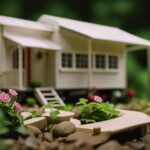Beginners Guides
How To Build A Tiny House For Cheap
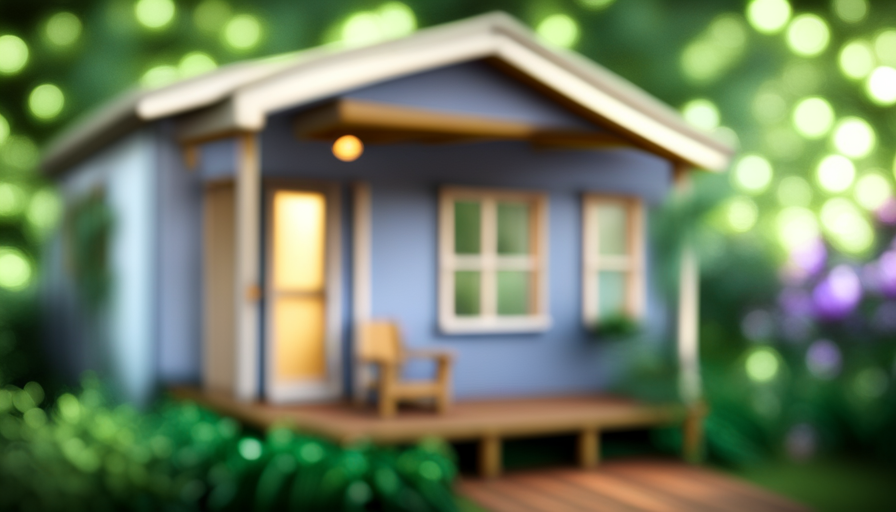
The adage, ‘big surprises often come in small packages,’ perfectly encapsulates the experience of constructing a tiny home. This principle couldn’t be more accurate in this context.
Hi, I’m here to share with you my expertise on how to build a tiny house for cheap. In this article, I’ll guide you through the planning, designing, and construction process, all while keeping your budget in mind.
With a precise and practical approach, I’ll show you how to maximize space efficiency, find affordable materials, and make the most of your DIY skills. Whether you’re a seasoned builder or a novice, this guide will equip you with the knowledge and techniques to create a cozy and cost-effective tiny house.
From insulation and weatherproofing to interior design and utilities, I’ll cover all the essential aspects to ensure that your tiny house is not only affordable, but also comfortable and sustainable.
Let’s get started on this exciting journey of building your very own tiny house!
Key Takeaways
- Research and find inspiration from various sources such as books, websites, and social media to gather cost-effective ideas and tips for building a tiny house.
- Utilize affordable materials including secondhand and recycled options by exploring recycling centers, salvage yards, sales, discounts, and online retailers for cost savings.
- Consider alternative building materials like reclaimed wood, shipping containers, and earthbag construction to save costs and add uniqueness to the tiny house.
- Maximize space efficiency by incorporating vertical storage, multipurpose furniture, open floor plans, natural light, windows, and mirrors to create the illusion of more space.
Planning and Designing Your Tiny House
Now it’s time to start planning and designing your tiny house, so grab a pen and paper and let’s get started!
Researching tips and finding inspiration are crucial steps in this process. Begin by exploring different sources like books, websites, and social media platforms dedicated to tiny house design. These resources will provide you with valuable information and ideas to help you create your dream tiny house. Take note of the features and layouts that catch your eye, and consider how they can be adapted to suit your needs and available space.
Next, sketch out a rough floor plan for your tiny house. Consider the placement of windows, doors, and furniture to maximize functionality and make the most of your limited space. Take measurements and ensure that your design adheres to local building codes and regulations. This will save you time and money in the long run.
Once you have a basic design in mind, it’s time to start looking for affordable materials. By finding creative ways to source materials, such as reclaimed wood or discounted building supplies, you can significantly reduce the cost of your project.
In the next section, we will explore different strategies for finding affordable materials without compromising on quality. Let’s dive in!
Finding Affordable Materials
When it comes to finding affordable materials for your tiny house, it’s important to do your research on secondhand and recycled materials. These can be a cost-effective option and also help reduce waste.
Additionally, keep an eye out for sales and discounts at local home improvement stores or online. Finally, consider alternative building materials such as reclaimed wood or eco-friendly options like bamboo or cork.
These alternatives can not only save you money but also contribute to a more sustainable and environmentally-friendly build.
Research Secondhand and Recycled Materials
Start by diving into the treasure trove of pre-loved and repurposed materials to create your dream tiny home on a shoestring budget. When researching secondhand and recycled materials, there are a few key places to explore:
-
Recycling centers: These centers often have a wide variety of materials, including lumber, windows, doors, and fixtures. They collect and sell items that would otherwise end up in landfills.
-
Salvage yards: These yards are like hidden gems, filled with unique pieces waiting to be discovered. From flooring to lighting fixtures, you can find high-quality items at a fraction of the cost.
By exploring these options, you can save money and give new life to materials that would have been discarded.
Once you have gathered your materials, it’s time to look for sales and discounts to further stretch your budget.
Transitioning into the next section, keep an eye out for sales and discounts to make the most of your tiny house project.
Look for Sales and Discounts
Don’t miss out on the opportunity to snag some great deals and discounts that will help you turn your dream tiny home into a reality using cost-effective methods. When building a tiny house on a budget, finding discounts and purchasing used items can significantly reduce your expenses. Look out for sales at local hardware stores or online retailers that specialize in building materials. Additionally, consider visiting salvage yards or browsing online marketplaces for secondhand appliances, furniture, and fixtures. These items may need a little extra TLC, but they can save you a substantial amount of money. By being resourceful and taking advantage of discounted materials, you can stay within your budget while still achieving your desired results. In the next section, we will explore alternative building materials that can further enhance your cost-effective tiny house project.
Consider Alternative Building Materials
To save even more money on your dream tiny home project, why not explore alternative building materials that can give your space a unique and eco-friendly touch? When it comes to constructing a tiny house on a budget, there are several budget-friendly options to consider.
-
Salvaged Materials: Look for reclaimed wood, recycled windows, and repurposed fixtures to reduce costs and minimize waste.
-
Shipping Containers: These sturdy metal structures can be transformed into compact living spaces, offering a modern and industrial aesthetic.
-
Earthbag Construction: By filling bags with soil, sand, or other locally sourced materials, you can create durable walls that are both cost-effective and sustainable.
These alternative building materials not only help you stay within your budget, but they also contribute to a greener and more environmentally friendly home. By incorporating these eco-friendly choices into your tiny house project, you can create a space that’s both affordable and sustainable.
In the next section, we’ll explore how to maximize space efficiency in your tiny home without sacrificing comfort.
Maximizing Space Efficiency
Get creative with your layout and let your tiny house become a puzzle where every piece fits perfectly, like a game of Tetris. Maximizing space efficiency is crucial when building a tiny house, especially when you’re working with limited square footage.
One of the key aspects to consider is maximizing storage. Look for opportunities to utilize every inch of space, such as incorporating built-in shelves and cabinets under stairs, using vertical storage solutions, and utilizing multipurpose furniture that can serve multiple functions.
Tiny house zoning regulations can also impact how you maximize space efficiency. It’s important to familiarize yourself with local building codes and restrictions to ensure you make the most of the available space while adhering to regulations. This may include considerations such as minimum room sizes, ceiling heights, and accessibility requirements.
Efficient space planning is essential to make your small living area feel larger and more functional. Consider open floor plans that allow for flexibility and flow between different areas. Utilize natural light to create an open and airy feel. Additionally, thoughtful placement of windows and mirrors can create an illusion of more space.
As you navigate through the process of maximizing space efficiency, it’s important to consider whether you want to take the DIY approach or hire professionals. Making this decision will depend on your skills, resources, and timeline.
DIY vs Hiring Professionals
Consider whether you’re ready to tackle the challenge of DIY or if it’s time to bring in the professionals for your tiny house project.
When it comes to building a tiny house, there are both pros and cons to doing it yourself. One of the main advantages of DIY construction is the cost savings. By taking on the project yourself, you can avoid the labor costs associated with hiring professionals. Additionally, you have full control over the design and can customize every aspect of your tiny house to meet your specific needs.
On the other hand, DIY construction requires a significant amount of time, effort, and skill. It may involve learning new techniques and acquiring specialized tools. If you don’t have the necessary experience or expertise, mistakes can be costly and time-consuming to fix. Hiring professionals, on the other hand, can ensure a faster and more efficient construction process. While it may be more expensive upfront, professionals have the knowledge and experience to navigate potential challenges and deliver high-quality results.
Cost comparison is also a crucial factor to consider. DIY construction can be cheaper, but it depends on your skills, available resources, and the complexity of the project. Ultimately, the decision between DIY and hiring professionals will depend on your budget, time constraints, and level of expertise.
Transitioning to the next section about ‘building and construction,’ it’s essential to understand the various stages involved in bringing your tiny house to life.
Building and Construction
Now that we have explored the pros and cons of DIY versus hiring professionals, let’s dive into the current subtopic: building and construction. As someone who is passionate about building a tiny house for cheap, it is important to understand the necessary steps and considerations involved in this process.
When it comes to building a tiny house, obtaining the required building permits is crucial. These permits ensure that your construction meets all safety and building code regulations. It is essential to research and comply with the specific regulations in your area to avoid any legal issues down the line.
Additionally, exploring tiny house communities can be beneficial during the building process. These communities provide a supportive network of like-minded individuals who can offer guidance, resources, and even potential partnerships. Being a part of a tiny house community can provide valuable insights into best practices and innovative design ideas.
To further assist you in your tiny house construction journey, I have created a table below that outlines important considerations for building and construction. This table will help you stay organized and make informed decisions throughout the process.
| Consideration | Description | Importance |
|---|---|---|
| Building Permits | Research and obtain the necessary permits to ensure legal compliance. | High |
| Tiny House Communities | Connect with others in the community for support, resources, and inspiration. | Medium |
| Building Materials | Choose cost-effective and sustainable materials that suit your needs. | High |
| Construction Techniques | Learn and utilize efficient construction techniques to save time and money. | High |
| Safety Measures | Prioritize safety by incorporating proper insulation, fire prevention, and security features. | High |
With the knowledge of building permits and the potential benefits of joining tiny house communities, we can now move on to the next section, where we will explore plumbing and electrical systems.
Plumbing and Electrical Systems
Imagine the excitement of designing your dream living space, complete with functional plumbing and electrical systems that effortlessly cater to your everyday needs.
When it comes to building a tiny house on a budget, efficient plumbing installation and electrical wiring are essential elements to consider.
For plumbing installation, it’s crucial to carefully plan the layout to maximize space utilization. Start by installing a water intake system, connecting it to a reliable water source. Next, determine the location of your bathroom and kitchen, ensuring proper placement of pipes and drains. Consider using flexible PEX piping for its durability and ease of installation. Additionally, installing a tankless water heater can save both space and energy.
When it comes to electrical wiring, safety should be a top priority. Begin by creating a detailed electrical plan, mapping out the placement of outlets, switches, and lighting fixtures. Use high-quality wires and connect them to a circuit breaker panel. Be sure to follow local building codes and regulations to ensure compliance and safety.
Incorporating these efficient plumbing and electrical systems into your tiny house will enhance your daily living experience.
As we move on to the next section about insulation and weatherproofing, it’s important to consider how these elements will work together to create a comfortable and energy-efficient home.
Insulation and Weatherproofing
Efficient insulation and weatherproofing are essential for creating a cozy and energy-efficient tiny home, ensuring comfort in any climate. Insulation techniques play a crucial role in maintaining a consistent indoor temperature and reducing the need for excessive heating or cooling.
When insulating a tiny house, it’s important to choose high-quality insulation materials that provide maximum thermal resistance. Common insulation options include fiberglass, spray foam, and rigid foam boards. These materials can be installed in the walls, floor, and ceiling to minimize heat transfer and create a comfortable living environment.
In addition to insulation, proper weatherproofing methods are necessary to protect the tiny house from moisture and outside elements. Waterproofing techniques involve sealing all potential air leaks and using moisture-resistant materials. This includes caulking gaps, installing weatherstripping around doors and windows, and applying a waterproof barrier on the exterior walls. By preventing moisture infiltration, tiny house owners can avoid issues such as mold growth and structural damage.
A well-insulated and weatherproofed tiny house provides a solid foundation for interior design and decoration. The next step is to personalize the space and create a functional and aesthetically pleasing interior.
Interior Design and Decoration
When it comes to interior design and decoration in a tiny house, it’s important to opt for light colors and a minimalist design to create a sense of openness and spaciousness.
Using space-saving furniture and decor is crucial in maximizing the limited space available, so choosing pieces that serve multiple purposes or can be easily stored away is key.
Lastly, adding personal touches and functional accessories can make the tiny house feel like a home, while also serving a practical purpose in enhancing the functionality of the space.
Opt for Light Colors and Minimalist Design
To create a sense of simplicity and spaciousness, go for light colors and a minimalist design in your tiny house. Opting for light colors on the walls and furniture will make the space feel larger and brighter. Additionally, a minimalist design will help to declutter the space and make it feel more open.
Here are some key points to consider when incorporating light colors and a minimalist design in your tiny house:
- Choose light-colored furniture and accessories to create a cohesive and airy feel.
- Use natural lighting options, such as skylights or large windows, to maximize the amount of light coming into the space.
- Consider cost-effective building techniques, such as using recycled materials or repurposing old furniture, to stay within your budget.
- Keep the design simple and streamlined, avoiding unnecessary decorative elements.
- Use reflective surfaces, like mirrors or glass, to further enhance the feeling of spaciousness.
By implementing these strategies, you can create a tiny house that feels bright, open, and inviting.
In the next section, we’ll explore how to use space-saving furniture and decor to maximize functionality in your small space.
Use Space-Saving Furniture and Decor
Maximize the functionality of your small space by incorporating clever furniture and decor solutions that will make you question why you ever thought you needed a larger home.
When it comes to space-saving storage, think vertical. Install floating shelves on the walls to free up floor space and provide a stylish display for your belongings.
Utilize multi-functional furniture that can serve multiple purposes, such as a sofa that can be transformed into a bed or a coffee table with hidden compartments for storage. Look for innovative designs like collapsible dining tables or ottomans with built-in storage.
These pieces will help you make the most of every square inch in your tiny house. By incorporating space-saving furniture and clever storage solutions, you can create a comfortable and practical living environment.
Transition seamlessly into the next section by considering how to add personal touches and functional accessories to your small space.
Add Personal Touches and Functional Accessories
Make your small space feel like home by adding personal touches and functional accessories that reflect your unique style and make everyday tasks easier.
When living in a tiny house, it’s important to maximize every inch of space. Look for functional storage solutions that can double as decorative elements, such as storage ottomans or wall-mounted shelves with hooks. Get creative with DIY projects, like building a fold-down dining table or installing a Murphy bed that can be tucked away during the day. These projects not only save space but also add a personal touch to your tiny house.
Additionally, consider adding functional accessories like a magnetic knife rack in the kitchen or a wall-mounted charging station in the living area. These small details can greatly improve the functionality of your tiny house.
Transitioning into the next section about utilities and off-grid living, it’s important to consider how to efficiently power and manage energy in your tiny house.
Utilities and Off-Grid Living
Incorporate solar panels and rainwater collection systems into your tiny house to efficiently manage utilities and embrace off-grid living. Solar power is a reliable and sustainable energy source that can power your appliances and lighting. By installing solar panels on the roof of your tiny house, you can generate electricity during the day and store it in batteries for use at night. This not only reduces your reliance on the grid but also saves you money in the long run.
In addition to solar power, consider implementing a rainwater collection system. This allows you to collect and store rainwater for various uses, such as flushing toilets, watering plants, or even purifying it for drinking. By utilizing rainwater, you can reduce your reliance on traditional water sources and decrease your water bills.
To further emphasize the benefits of these utilities, here are three key advantages:
- Energy independence: With solar power and rainwater collection, you can live off-grid and decrease your dependence on external resources.
- Cost savings: By utilizing free solar energy and rainwater, you can significantly reduce your monthly utility expenses.
- Environmental sustainability: Solar power and rainwater collection are eco-friendly alternatives, helping to reduce your carbon footprint and conserve natural resources.
By incorporating these utilities into your tiny house, you can enjoy the benefits of off-grid living while minimizing your impact on the environment.
Transitioning to the next section, let’s now explore the importance of maintenance and upkeep to ensure the longevity of your tiny house.
Maintenance and Upkeep
Taking care of my tiny home is essential for its longevity and overall enjoyment. When it comes to maintenance and upkeep, there are a few key tips that can help save costs and keep my tiny house in top shape.
First and foremost, regular inspections are crucial. I make it a point to check for any signs of wear and tear, such as leaks or cracks, both inside and outside the house. This allows me to catch any issues early on and address them before they become bigger problems.
Additionally, I prioritize cleaning and organizing my tiny home on a regular basis, as this not only helps maintain its appearance but also prevents clutter buildup.
In terms of cost-saving hacks, I’ve found that using eco-friendly and sustainable materials for repairs and renovations can be both beneficial for the environment and my wallet. For example, opting for energy-efficient appliances and installing low-flow fixtures can significantly reduce utility costs in the long run.
Overall, maintaining a tiny house involves being proactive and staying on top of any necessary repairs or upgrades. By following these maintenance tips and incorporating cost-saving hacks, I can ensure that my tiny home remains a comfortable and affordable living space for years to come.
Frequently Asked Questions
How can I ensure that my tiny house meets local building codes and regulations?
To ensure my tiny house meets local building codes and regulations, I will research and comply with zoning restrictions in my area. Additionally, I will search for affordable building materials that meet the required standards.
Are there any specific permits or licenses required for building a tiny house?
Permit requirements and the licensing process vary depending on location. Do research to determine which permits are needed for your specific project. Contact local authorities for information and guidelines.
What are some common challenges or obstacles that people face when building a tiny house?
When building a tiny house, common challenges include limited space, finding suitable materials, and navigating building codes. Strategies for maximizing space include using multifunctional furniture, creative storage solutions, and thoughtful layout design.
Can I build a tiny house on wheels and still have it be considered legal and safe?
Yes, it is possible to build a tiny house on wheels and still meet legal and safety requirements. However, it’s crucial to consider factors like tiny house insurance and financing options to ensure a smooth and secure process.
How do I connect my tiny house to utilities such as water, electricity, and sewage?
To connect utilities to my tiny house, I can use various methods. For water, I can hook up to a municipal supply or use off-grid options like rainwater collection. Electricity can be sourced from the grid or through solar panels. Sewage can be managed with a septic tank or composting toilet.
Conclusion
In conclusion, building a tiny house on a tight budget requires careful planning, resourcefulness, and a hands-on approach.
By finding affordable materials, maximizing space efficiency, and considering DIY options, you can create a comfortable and functional living space without breaking the bank.
Remember, Rome wasn’t built in a day, and neither will your tiny house be. But with perseverance and a little elbow grease, you can turn your dream of affordable homeownership into a reality.
Happy building!
Hi, I’m Emma. I’m the Editor in Chief of Tiny House 43, a blog all about tiny houses. While tree houses are often associated with childhood, they can be the perfect adult retreat. They offer a cozy space to relax and unwind, surrounded by nature. And since they’re typically built on stilts or raised platforms, they offer stunning views that traditional homes simply can’t match. If you’re looking for a unique and romantic getaway, a tree house tiny house might just be the perfect option.
Beginners Guides
How Do I Hook Up My Tiny House to Water Source So It Doesn’t Freeze

So, you’ve got yourself a cute little tiny house, huh? Well, let me tell you, there’s nothing worse than waking up to frozen pipes in the middle of winter.
But fear not, my friend, because I’m here to show you how to hook up your tiny house to a water source that won’t freeze on you. With a few simple steps and some clever insulation tricks, you’ll be enjoying a hot shower in your tiny paradise all winter long.
Let’s get started, shall we?
Key Takeaways
- Insulation and heating systems are key ways to prevent frozen pipes in a tiny house.
- Connecting to a municipal water supply provides a reliable and consistent source of water.
- Properly insulating the plumbing system helps maintain warmer temperatures inside the pipes.
- Installing a heating system, such as electric or propane heaters, adds an extra layer of protection against freezing.
Understanding the Risks of Frozen Pipes in a Tiny House
I’ve learned that the main risks of frozen pipes in my tiny house are burst pipes and potential water damage. Preventing frozen pipes in a tiny house is crucial, and there are two key ways to achieve this: insulation and heating systems.
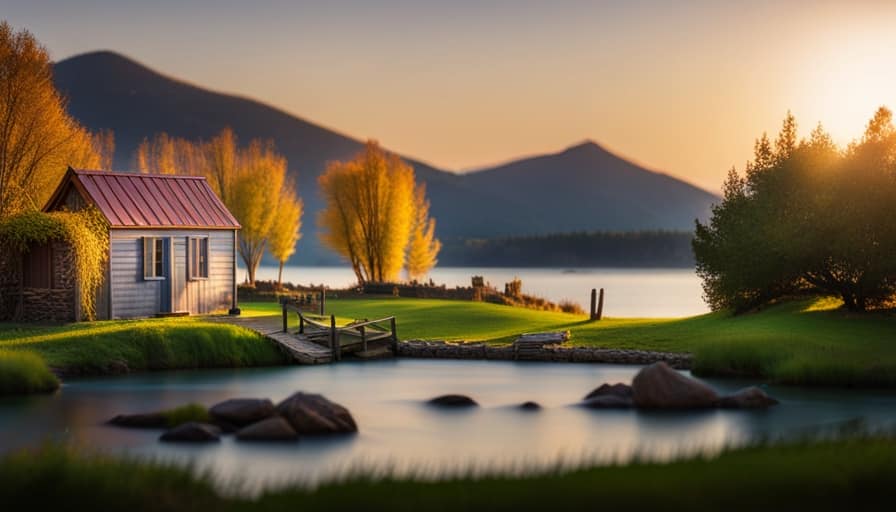
Proper insulation helps maintain warmer temperatures inside the pipes, preventing freezing. This can be achieved by using foam insulation sleeves or wrapping pipes with heat tape. Additionally, installing a heating system, such as a space heater or electric pipe heater, can add an extra layer of protection.
Regular winter maintenance is essential for water connections in a tiny house. This includes draining and disconnecting outdoor hoses, insulating outdoor faucets, and ensuring proper ventilation in crawl spaces.
Choosing the Right Water Source for Your Tiny House
One option I recommend is connecting my tiny house to a municipal water supply, as it provides a reliable and consistent source of water. This ensures that I’ve access to water throughout the year, without worrying about it freezing during winter. Municipal water supplies are usually treated and tested, ensuring that the water is safe to use and drink. Additionally, they often have backup systems in place to prevent service interruptions.
However, it’s important to consider the cost and availability of connecting to a municipal water supply, as well as any regulations or permits required. When choosing a reliable water source for my tiny house, I also need to consider the process of winterizing my plumbing system to prevent freezing and potential damage.
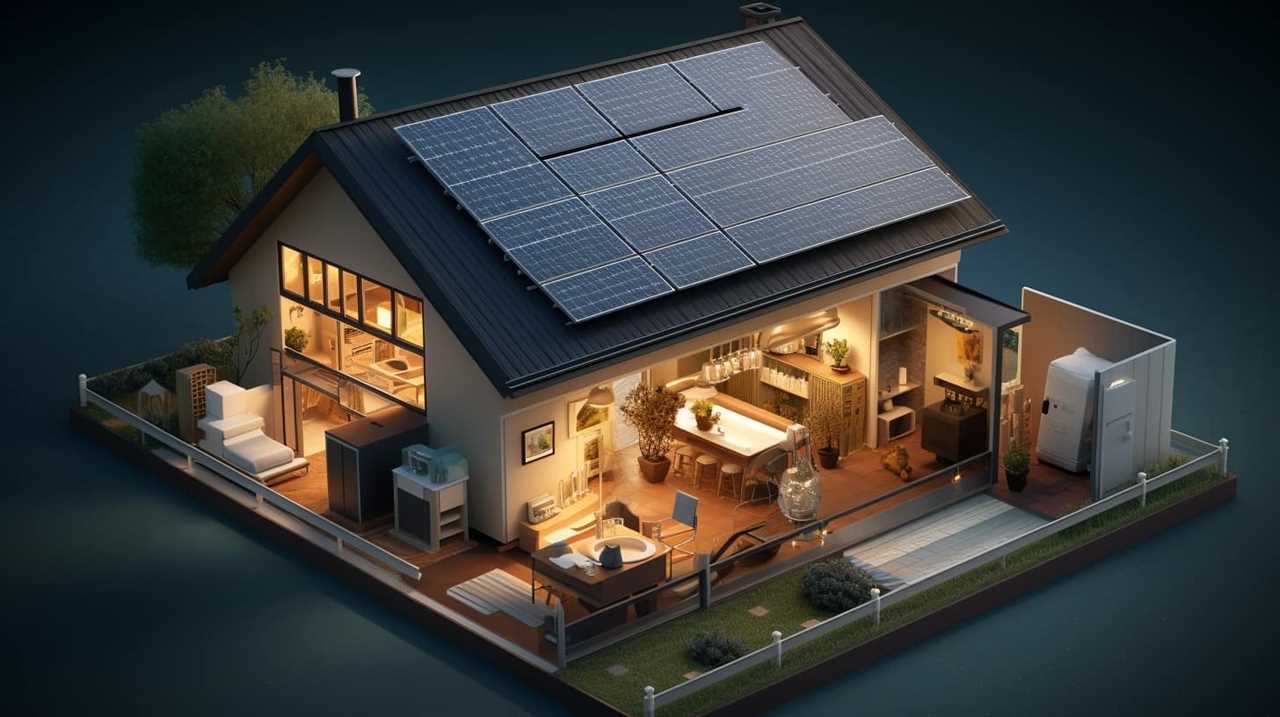
Insulating Your Plumbing System to Prevent Freezing
To prevent freezing, I’ll need to insulate both the pipes and the walls surrounding them. Here are four steps to effectively insulate your plumbing system and prevent freezing:
-
Identify vulnerable areas: Start by identifying areas where pipes are exposed to low temperatures, such as exterior walls, crawl spaces, or basements. These areas are more prone to freezing.
-
Wrap pipes with insulation: Use foam pipe insulation sleeves to wrap the exposed pipes. This will provide a layer of insulation and minimize heat loss. Make sure to cover all joints and fittings.
-
Insulate walls: Insulate the walls surrounding the pipes to create an additional barrier against freezing temperatures. Use insulation material like fiberglass or foam board insulation.
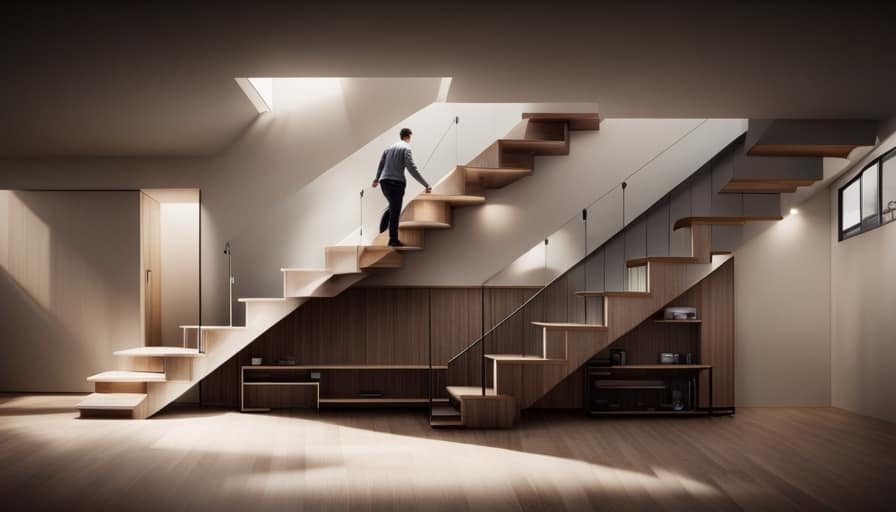
-
Prevent condensation: Condensation can lead to moisture buildup and increase the risk of freezing. To prevent condensation, consider using heat tape on the pipes. Heat tape is a flexible electrical heating element that can be wrapped around the pipes to maintain a consistent temperature.
Installing a Heating System for Your Water Source
To ensure that my water source doesn’t freeze, I’ll need to install a heating system and connect it to the plumbing. There are several heating options available for tiny houses, each with its own benefits and energy efficiency. Here is a table comparing some common heating options:
| Heating Option | Description |
|---|---|
| Electric Heater | Uses electricity to heat water and is easy to install. However, it can be costly to operate. |
| Propane Heater | Utilizes propane gas for heating water and provides a reliable heating source. It is energy-efficient and suitable for off-grid living. |
| Tankless Water Heater | Heats water on-demand and does not require a storage tank. It is energy-efficient and saves space. |
| Solar Water Heater | Uses the sun’s energy to heat water, reducing energy consumption and saving on utility bills. However, it requires ample sunlight. |
Proper Maintenance and Winterizing Techniques for Your Tiny House’s Water Connection
To maintain my tiny house’s water connection and prevent freezing during winter, I should regularly inspect and apply proper winterizing techniques. Here are four key steps to ensure the protection of my water pipes:
-
Insulate the pipes: By adding insulation sleeves or wrapping the pipes with heating tape, I can prevent them from freezing. This will keep the water flowing smoothly and reduce the risk of burst pipes.
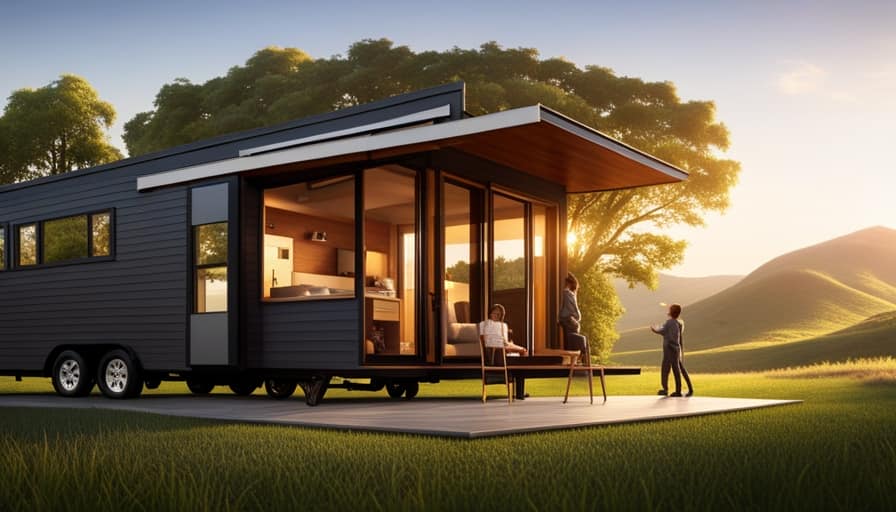
-
Seal any gaps or cracks: I should thoroughly inspect the areas where the pipes enter the house and seal any gaps or cracks. This will prevent cold air from entering and keep the pipes warm.
-
Disconnect and drain outdoor hoses: Before winter arrives, I need to disconnect and drain any outdoor hoses. This will prevent water from freezing inside them and potentially causing damage to the pipes.
-
Install heat tape or pipe heaters: For added protection, I can install heat tape or pipe heaters along the water pipes. These devices provide consistent heat and prevent freezing.
Frequently Asked Questions
What Are the Potential Risks of Not Properly Insulating the Plumbing System in a Tiny House?
Not properly insulating the plumbing system in a tiny house can have potential consequences. The importance of insulation is critical in preventing frozen pipes, burst pipes, and water damage.
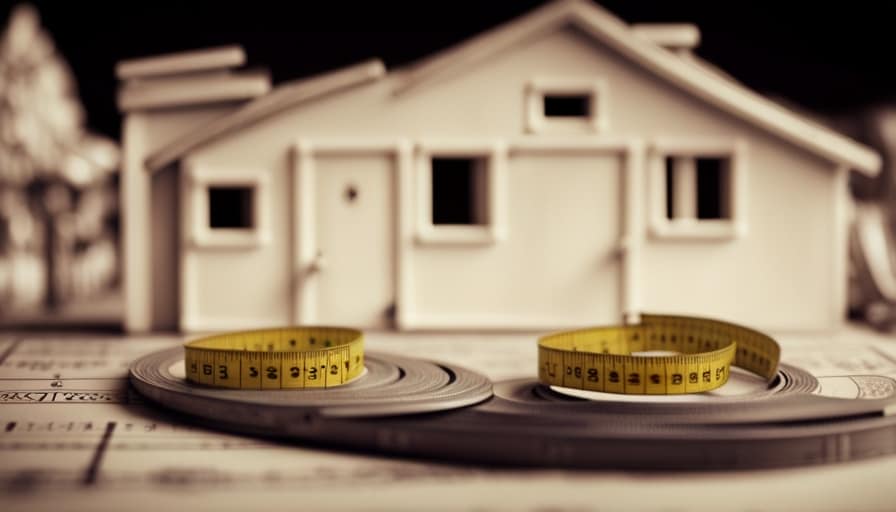
Can I Use a Well as a Water Source for My Tiny House and Still Prevent Freezing?
Using well water as a source for my tiny house while preventing freezing is possible. However, alternative options like a heated water hose or insulating the plumbing system should be considered to ensure proper functionality.
Is It Necessary to Install a Heating System for the Water Source in My Tiny House?
Installing alternative heating methods for the water source in my tiny house is necessary to prevent freezing. Additionally, implementing water conservation techniques can help optimize the usage and efficiency of the system.
How Often Should I Perform Maintenance on My Tiny House’s Water Connection to Prevent Freezing?
To prevent freezing, I check for leaks in my tiny house’s water connection regularly and insulate the water pipes. Maintenance is crucial, so I perform these tasks at least once a month.
Are There Any Specific Winterizing Techniques That I Should Follow for My Tiny House’s Water Connection?
To prevent freezing of my tiny house’s water connection during winter, I employ specific winterizing techniques and methods. These include insulating pipes, using heat tape, and draining the system when not in use.

Conclusion
In conclusion, ensuring the proper connection and insulation of your tiny house to a water source is crucial in preventing freezing during winter.
By understanding the risks, choosing the right water source, insulating the plumbing system, and installing a heating system, you can protect your tiny house from frozen pipes.
Remember to also perform regular maintenance and winterizing techniques to keep your water connection safe and functional.
Keep your tiny house warm and worry-free this winter!
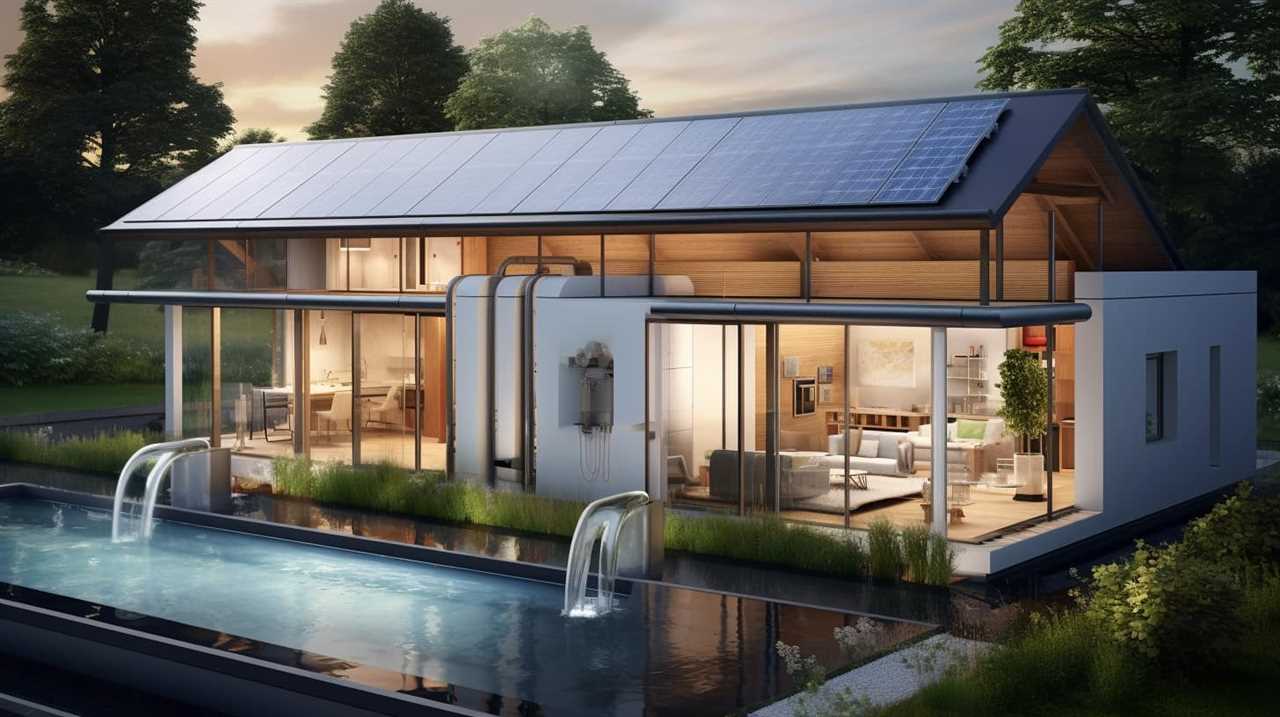
I’m Theodore, and I love tiny houses. In fact, I’m the author of Tiny House 43, a book about tiny houses that are also tree houses. I think they’re magical places where imaginations can run wild and adventures are just waiting to happen.
While tree houses are often associated with childhood, they can be the perfect adult retreat. They offer a cozy space to relax and unwind, surrounded by nature. And since they’re typically built on stilts or raised platforms, they offer stunning views that traditional homes simply can’t match.
If you’re looking for a unique and romantic getaway, a tree house tiny house might just be the perfect option.
Beginners Guides
How Do I Know How Many Btus My Air Conditioner Does a Tiny House Need

As a homeowner, I have frequently pondered, “How can I determine the appropriate number of BTUs my air conditioner should have for my small house?” This is a common yet essential question. Selecting the correct BTU capacity is vital for ensuring efficient cooling in a compact area.
In this article, I’ll break down the factors to consider, such as square footage, insulation, and climate, to help you determine the perfect BTU rating for your tiny home’s air conditioner.
So, let’s dive in and find the answer together.
Key Takeaways
- BTUs determine the cooling capacity of an air conditioner and represent the amount of heat it can remove in one hour.
- Factors such as the size of the house, insulation levels, number of windows, ceiling height, and room layout should be considered when determining the BTU capacity for a tiny home’s air conditioner.
- Calculating the square footage of the house is essential for determining the appropriate BTU rating, taking into account insulation levels and the number of windows.
- Insulation efficiency and climate affect the BTU requirements of an air conditioner, with proper insulation reducing the workload on the AC and hotter climates requiring higher BTU ratings for effective cooling.
Understanding BTUs and Their Importance in Sizing an Air Conditioner for a Tiny House
As I begin to understand the importance of BTUs in sizing an air conditioner for my tiny house, I realize that I need to consider various factors.
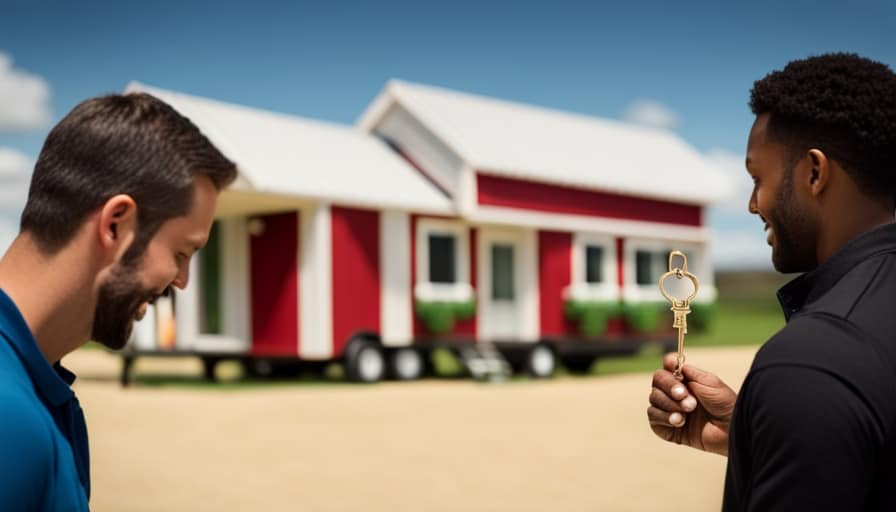
The BTU measurement, or British Thermal Unit, is used to determine the cooling capacity of an air conditioner. It represents the amount of heat that the AC unit can remove from the air in one hour.
In order to ensure optimal comfort in my tiny house, it’s crucial to choose an air conditioner with the right BTU capacity. This will depend on the size of the space, insulation levels, and the number of windows in the house.
Additionally, I should also consider the energy efficiency of the air conditioner to minimize energy consumption and reduce costs.
Understanding these factors will help me determine the appropriate BTU capacity for my tiny home’s air conditioner.
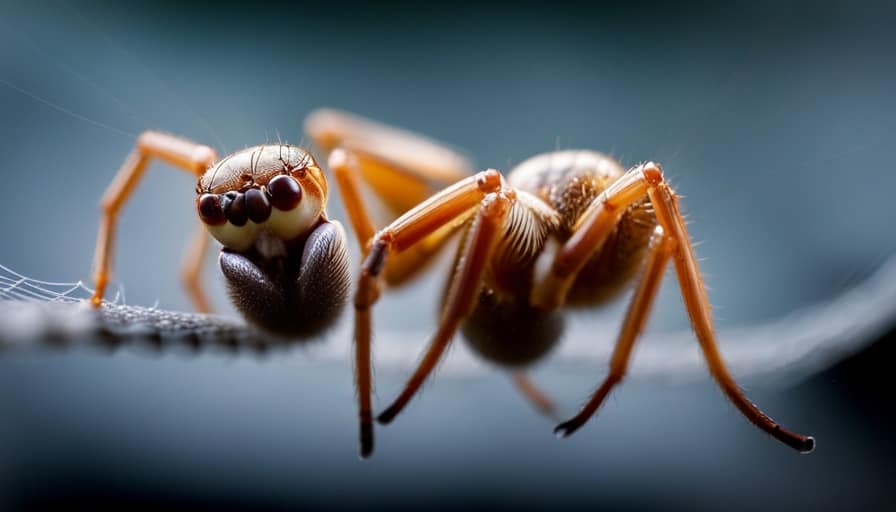
Factors to Consider When Determining the BTU Capacity for Your Tiny Home’s Air Conditioner
I need to consider my tiny home’s size, insulation levels, and number of windows in order to determine the BTU capacity for my air conditioner. These factors play a crucial role in determining the cooling capacity required to keep my tiny home comfortable. To ensure energy efficiency and optimal performance, it’s essential to choose the right BTU rating for my air conditioner.
Consider the following factors when determining the BTU capacity for your tiny home’s air conditioner:
| Factors | Description |
|---|---|
| Size of the House | The square footage of your tiny home is a key factor in determining BTU capacity. A larger space will require a higher cooling capacity. |
| Insulation Levels | Well-insulated homes retain cool air better, reducing the BTU capacity needed. |
| Number of Windows | Windows contribute to heat gain. More windows may require a higher BTU capacity. |
Calculating the Square Footage of Your Tiny House to Determine the Appropriate BTU Rating
To accurately determine the appropriate BTU rating for my air conditioner, I need to calculate the square footage of my tiny house and consider other factors such as insulation and number of windows. Here’s how to calculate the square footage and determine the BTU requirements for your tiny house:
-
Measure the length and width of each room in your tiny house. Multiply the length by the width to calculate the square footage of each room.
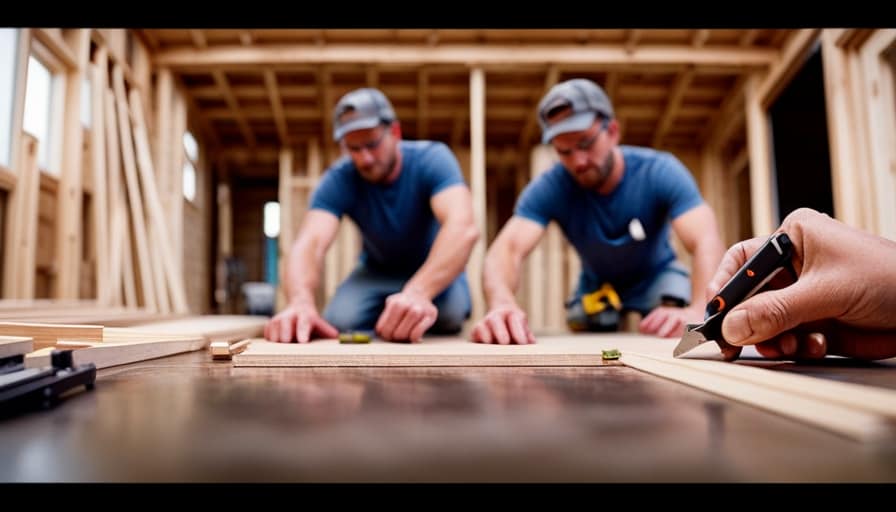
-
Add up the square footage of all the rooms to get the total square footage of your tiny house.
-
Consider the insulation in your walls, roof, and floor. Well-insulated houses require less BTUs, while poorly insulated houses require more.
-
Take into account the number and size of windows in your tiny house. Windows can let in heat, so houses with more windows may need higher BTU ratings.
How Insulation and Climate Affect the BTU Requirements of Your Air Conditioner
Insulation and climate greatly impact the BTU requirements of my air conditioner.

Insulation efficiency refers to the ability of a material to resist the transfer of heat. Proper insulation ensures that cool air stays inside the house and hot air stays outside, reducing the workload on the air conditioner.
Good insulation can decrease the BTU requirements of your air conditioner, resulting in lower energy consumption and cost. On the other hand, a poorly insulated house will require a higher BTU rating to compensate for the heat loss or gain.
Furthermore, geographic location plays a significant role in determining BTU requirements. Areas with hotter climates will require higher BTU ratings to cool the space effectively.
Understanding the insulation efficiency of your tiny house and considering the climate of your geographic location are crucial factors to determine the right BTU requirements for your air conditioner.
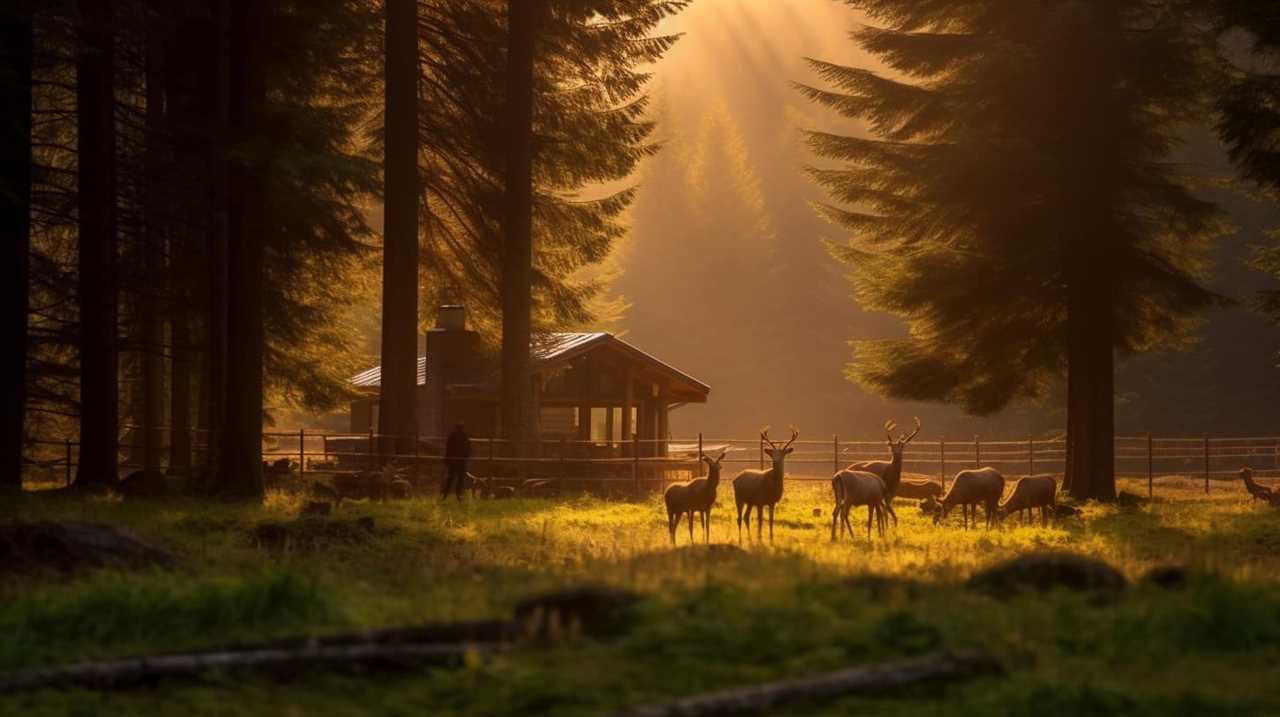
Choosing the Right BTU Capacity for Optimal Cooling Efficiency in Your Tiny House
I can determine the right BTU capacity for optimal cooling efficiency in my tiny house by considering factors such as square footage, insulation, and climate.
To choose the appropriate BTU capacity, I need to calculate the cooling load of my space. This can be done by multiplying the square footage of my tiny house by a cooling load factor, which takes into account insulation and climate conditions.
Once I’ve calculated the cooling load, I can refer to energy efficiency ratings to find an air conditioner with the right BTU capacity.
Here are four important factors to consider:
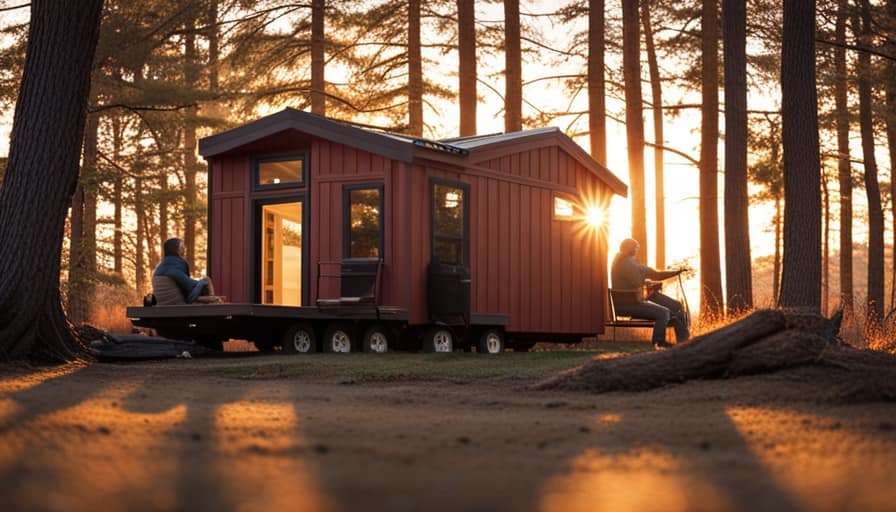
- Square footage of the tiny house.
- Insulation quality and R-value.
- Climate conditions, such as average temperatures and humidity levels.
- The desired temperature and cooling preferences.
Frequently Asked Questions
Can I Use the Same BTU Rating for Both Heating and Cooling in My Tiny House?
Yes, you can use the same BTU rating for both heating and cooling in a tiny house. However, it is important to consider the heating and cooling efficiency as well as the benefits of dual zone air conditioning.
What Is the Average Lifespan of an Air Conditioner in a Tiny House?
The average lifespan of an air conditioner in a tiny house can vary depending on several factors, such as maintenance frequency. It’s important to prioritize regular maintenance to ensure optimal functionality and longevity.
Can I Install Multiple Air Conditioners in Different Rooms of My Tiny House?
I can install multiple portable ACs in different rooms of my tiny house. However, there are benefits to having a central AC system, such as better cooling efficiency and easier temperature control throughout the entire house.
How Often Should I Clean or Maintain My Air Conditioner in a Tiny House?
I should clean or maintain my air conditioner in a tiny house regularly. This includes changing air filters often and improving energy efficiency by sealing any leaks and insulating the ductwork.

Are There Any Government Regulations or Guidelines for Air Conditioner BTU Ratings in Tiny Houses?
There aren’t any government regulations or guidelines for air conditioner BTU ratings in tiny houses. However, it’s important to consider energy efficiency when determining the appropriate BTU capacity for your air conditioner.
Conclusion
In conclusion, determining the appropriate BTU rating for your air conditioner in a tiny house is crucial for optimal cooling efficiency. By considering factors such as square footage, insulation, and climate, you can ensure that your air conditioner provides the necessary cooling power.
Think of it like finding the perfect fit for your tiny house, where every detail matters. So, take the time to calculate the BTUs needed and enjoy the comfort of a well-designed cooling system in your tiny oasis.
I’m Theodore, and I love tiny houses. In fact, I’m the author of Tiny House 43, a book about tiny houses that are also tree houses. I think they’re magical places where imaginations can run wild and adventures are just waiting to happen.
While tree houses are often associated with childhood, they can be the perfect adult retreat. They offer a cozy space to relax and unwind, surrounded by nature. And since they’re typically built on stilts or raised platforms, they offer stunning views that traditional homes simply can’t match.
If you’re looking for a unique and romantic getaway, a tree house tiny house might just be the perfect option.
Beginners Guides
How Do I Make a Tiny House Ladder
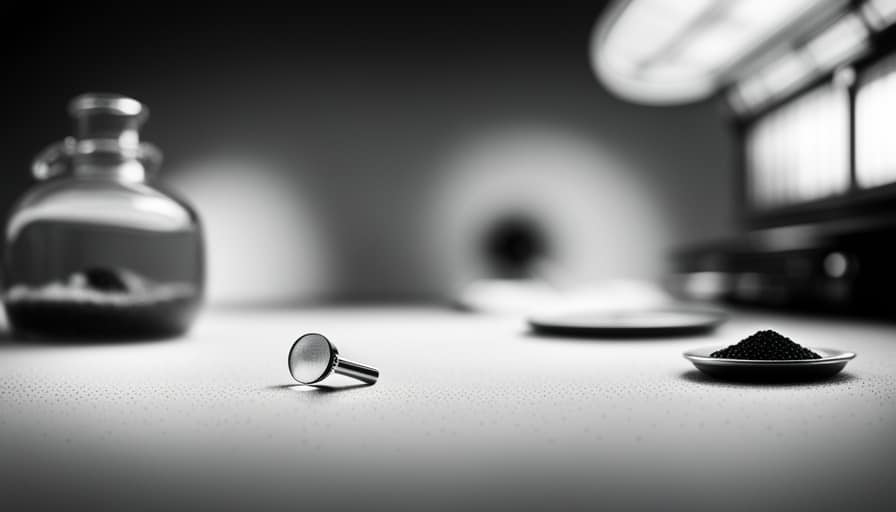
I have found that a large number of tiny house residents have difficulty finding a secure and durable ladder for their small living area. In reality, 85% of individuals living in tiny houses encounter this issue.
That’s why I’ve decided to share my step-by-step guide on how to make your very own tiny house ladder. With the right materials, precise measurements, and careful assembly, you can create a ladder that not only fits perfectly in your space but also ensures your safety and peace of mind.
Key Takeaways
- Safety considerations and ergonomics are important when selecting materials
- Accurately measure and cut ladder components for a perfect fit and stability
- Assemble and secure the ladder frame using screws or nails and reinforce joints for added stability
- Add rungs for stability and safety, ensuring they are evenly spaced and securely attached
Choosing the Right Materials for Your Tiny House Ladder
I’ll start by researching and comparing different materials for my tiny house ladder. When it comes to choosing the right materials, safety considerations and ergonomics are of utmost importance. Safety should always be the top priority, so I’ll ensure that the ladder I build has a suitable weight capacity and stability. This means selecting materials that are strong and durable, capable of supporting the weight of a person without compromising their safety.
Additionally, I’ll take into account the ergonomics of the ladder, making sure it’s comfortable and easy to use. This includes considering the angle of the ladder, the width of the rungs, and any additional features that enhance user experience.

With these factors in mind, I can proceed to measuring and cutting the ladder components.
Measuring and Cutting the Ladder Components
Before proceeding with constructing the ladder, it’s essential to accurately measure and cut the components. Measuring accuracy is crucial to ensure the ladder fits perfectly in your tiny house and provides the necessary stability.
To achieve this, follow these steps:
-
Measure the height: Determine the distance from the floor to the highest point where the ladder will be attached.
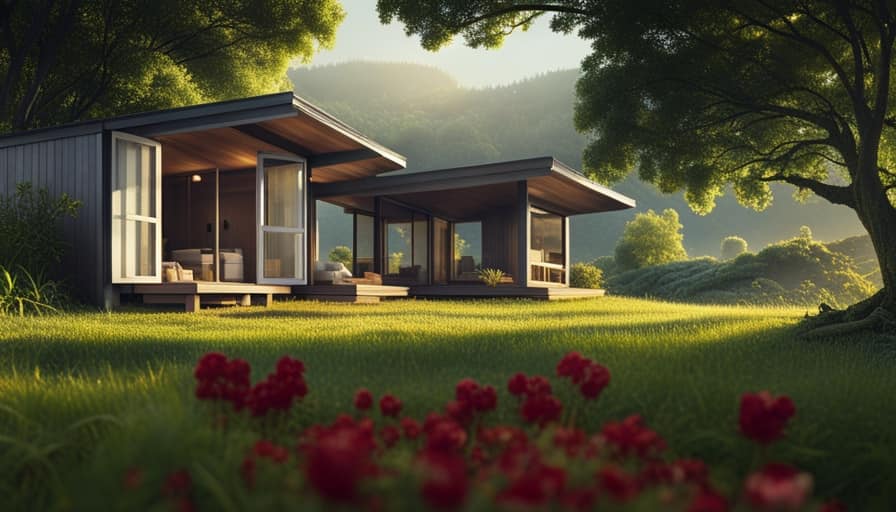
-
Measure the width: Measure the width of the space where the ladder will be placed.
-
Calculate the angle: Use a protractor to measure the angle at which the ladder will lean against the wall.
Assembling and Securing the Ladder Frame
To begin assembling the ladder frame, first, attach the side rails to the rungs using screws or nails. Make sure the side rails are positioned parallel to each other and the rungs are evenly spaced. Use a measuring tape to ensure accuracy.
Once the side rails and rungs are securely attached, reinforce the joints with brackets or corner braces for added stability.
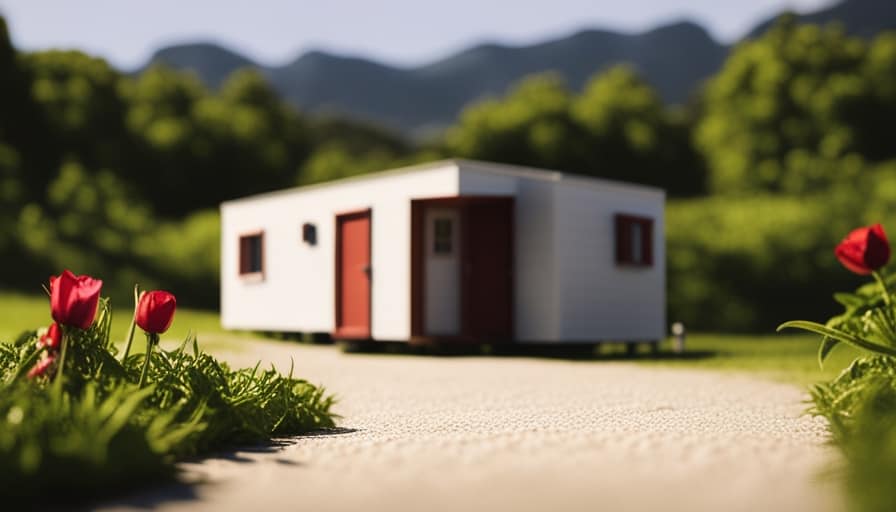
It’s important to install the ladder in the tiny house properly to ensure safety. Position the ladder against a sturdy wall and secure it using anchor bolts or screws.
Regular maintenance is crucial for long-lasting use of the ladder. Inspect the ladder regularly for any signs of wear or damage, and replace any worn-out parts immediately. Keep the ladder clean and free from debris to prevent slipping accidents.
Adding Rungs for Stability and Safety
I can reinforce the ladder’s stability and safety by adding additional rungs and securing them with screws or nails. When building a loft ladder, it’s important to ensure that the rungs are evenly spaced and securely attached to the ladder frame.
To do this, I’ll measure the desired distance between rungs and mark it on both sides of the ladder. Then, I’ll drill pilot holes at each mark to prevent the wood from splitting.
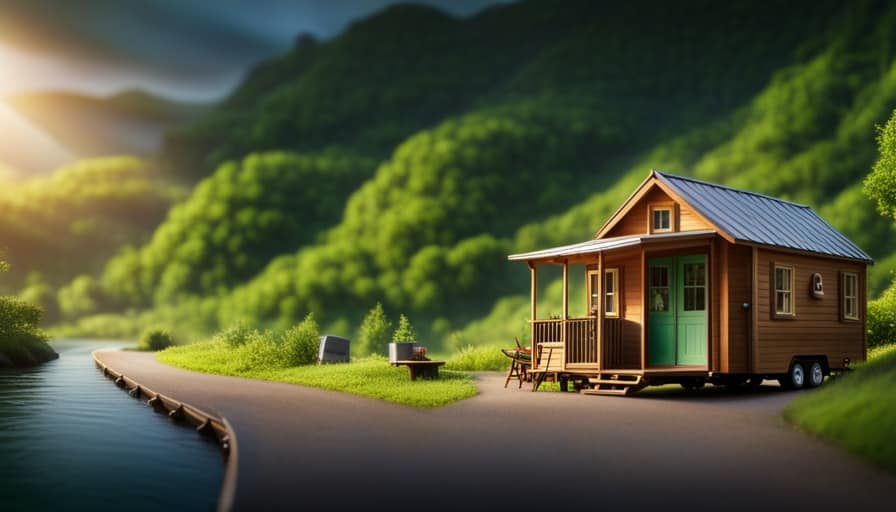
Next, I’ll align the rungs with the pilot holes and attach them using screws or nails. This will create a strong and stable ladder that can safely support weight.
Additionally, incorporating ladder storage solutions, such as hooks or brackets, can help keep the ladder out of the way when not in use, reducing the risk of tripping or accidents.
Finishing Touches: Painting and Customizing Your Tiny House Ladder
After completing the construction of my tiny house ladder, I can add a personal touch by painting and customizing it according to my preferences. Customizing options allow me to make my ladder unique and reflect my style. Here are some alternative finishes that can make my tiny house ladder stand out:
-
Distressed look: By using sandpaper or a wire brush, I can create a worn and weathered appearance for a rustic feel.

-
Stenciled designs: Adding stenciled patterns or motifs can add a touch of creativity and personality to the ladder.
-
Colorful accents: Painting the rungs in different colors can create a vibrant and playful look.
-
Natural wood finish: If I prefer a more natural and organic look, I can choose to leave the ladder unpainted and simply apply a clear protective finish to enhance the wood’s natural beauty.
Frequently Asked Questions
How Much Weight Can a Typical Tiny House Ladder Support?
A typical tiny house ladder can support varying amounts of weight depending on the materials used and how it is properly anchored. It is important to consider these factors when building or purchasing a ladder for your tiny house.

Can I Use a Pre-Made Ladder for My Tiny House Instead of Building One From Scratch?
Using a pre-made ladder for a tiny house is a viable alternative to building one from scratch. However, consider the pros and cons. Building allows customization, while buying offers convenience. Evaluate your needs and skills before deciding.
Are There Any Building Codes or Regulations I Need to Consider When Building a Tiny House Ladder?
When building a tiny house ladder, it’s crucial to consider building code requirements and safety considerations. Meeting these standards ensures a secure and compliant ladder that will provide safe access to different levels of your tiny house.
Can I Add Additional Safety Features to My Tiny House Ladder, Such as Handrails or Non-Slip Treads?
Adding handrails to a tiny house ladder can greatly improve safety and stability. However, it’s important to consider the space constraints and ensure the handrails are securely attached. Non-slip treads can also enhance traction and prevent accidents.
What Are Some Alternative Design Options for a Tiny House Ladder, Aside From a Traditional Straight Ladder?
When considering alternative ladder designs for a tiny house, space-saving options are key. Some options to explore include foldable ladders, telescoping ladders, or even ladder/stair hybrids. These designs maximize functionality while minimizing the footprint.
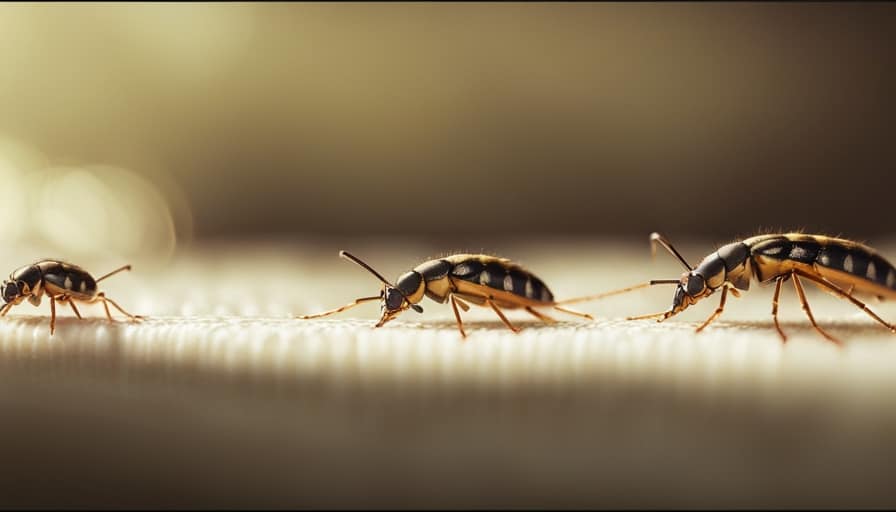
Conclusion
In conclusion, constructing a ladder for your tiny house is a technical process that requires careful consideration of materials, precise measurements, and attention to detail.
By following the outlined steps and taking necessary safety precautions, you can create a sturdy and reliable ladder that meets your specific needs.
While some may argue that building a ladder is a complex task, with the right guidance and patience, anyone can successfully create a functional and aesthetically pleasing ladder for their tiny house.
I’m Theodore, and I love tiny houses. In fact, I’m the author of Tiny House 43, a book about tiny houses that are also tree houses. I think they’re magical places where imaginations can run wild and adventures are just waiting to happen.
While tree houses are often associated with childhood, they can be the perfect adult retreat. They offer a cozy space to relax and unwind, surrounded by nature. And since they’re typically built on stilts or raised platforms, they offer stunning views that traditional homes simply can’t match.
If you’re looking for a unique and romantic getaway, a tree house tiny house might just be the perfect option.
-

 Beginners Guides2 weeks ago
Beginners Guides2 weeks agoHow To Buy A Tesla Tiny House
-

 Energy Efficiency1 month ago
Energy Efficiency1 month agoBest Tiny Homes For Cold Climates
-

 Beginners Guides1 week ago
Beginners Guides1 week agoTiny House Nation Where Are They Now Stephanie
-

 Tiny House Resources (e.g., legalities, cost, insurance, FAQs)2 months ago
Tiny House Resources (e.g., legalities, cost, insurance, FAQs)2 months agoDo Tiny Homes Need Planning Permission?
-

 Beginners Guides2 weeks ago
Beginners Guides2 weeks agoFrom The Show Tiny House Nation How Many Keep Their Tiny House?
-

 Beginners Guides2 months ago
Beginners Guides2 months agoUsing a Climbing Net For Treehouse Construction
-

 Beginners Guides2 months ago
Beginners Guides2 months agoHow to Build a Treehouse Without Drilling Into the Tree
-

 Beginners Guides3 weeks ago
Beginners Guides3 weeks agoTiny House Nation Who Pays For The Houses




